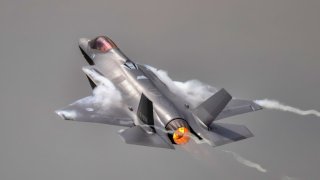F-35: The Stealth Fighter No Nation Can Match
The F-35 Lightning II is a pivotal asset in modern air superiority, essential for conventional warfare success. With over 811,000 flight hours and operations across 32 bases worldwide, it represents a key component of the U.S. military and its allies' defense strategy.
Summary: The F-35 Lightning II is a pivotal asset in modern air superiority, essential for conventional warfare success. With over 811,000 flight hours and operations across 32 bases worldwide, it represents a key component of the U.S. military and its allies' defense strategy. Currently, 18 countries participate in the F-35 program, highlighting its global significance. Despite its achievements, the program faces challenges, notably production delays due to the pending TR-3 software update, essential for enhancing the jet's capabilities. Lockheed Martin has produced over 1,000 F-35s, but the Pentagon has accepted fewer, awaiting this crucial update. Solving this issue is paramount as active global orders reach 3,500, and more countries express interest in joining the F-35 family.
F-35 Lightning II: Spearheading Modern Air Superiority Amid Production Challenges
Air power is perhaps the most important element of large-scale conventional warfare. Establishing air superiority over the battlefield helps ground and naval forces succeed.
There is no better tool to establish air superiority than the F-35 Lightning II stealth fighter jet. The F-35 is the best aircraft of its generation. The U.S. military and a number of allies and partners rely on the fifth-generation fighter.
Here are some fast facts about the state of the F-35 program.
Fast Facts on the F-35 Stealth Fighter
As of March, F-35 Lighting IIs of all types have logged more than 811,000 flight hours in more than 486,000 operational and training sorties.
More than 2,360 pilots have qualified to fly the stealth fighter, with over 15,600 maintainers licensed to support it on the ground.
Right now, 32 bases around the world and 12 ships can host and support the F-35. The U.S. Navy has the greatest number of qualified warships, with five amphibious assault ships (the USS Essex, USS Wasp, USS America, USS Makin Island, and USS Boxer) and three aircraft carriers (the USS Abraham Lincoln, USS Carl Vinson, and USS George Washington). The Royal Navy comes next with its two aircraft carriers, the HMS Queen Elizabeth and HMS Prince of Wales, followed by the Italian Navy with its aircraft carrier ITS Cavour, which should be joined later in 2024 by the landing helicopter dock ship ITS Trieste.
Right now, there are 18 countries participating in the F-35 Program. Several other countries have expressed their interest, formally or informally, in joining the F-35 family.
The F-35 Lightning II is a multi-role aircraft. Its three versions (A, B, and C) come with slightly different capabilities. The F-35A operates from conventional runways, the F-35B is a Short Take-off, Vertical Landing aircraft that can take off and land like a helicopter, and the F-35C can operate from aircraft carriers.
A Lingering Issue for F-35
As we have previously discussed in The National Interest, the F-35 Joint Strike Fighter program has been suffering from production delays.
Currently, Lockheed Martin is producing aircraft, but the Pentagon isn’t accepting finished models because they lack an important software update. The manufacturing company to date has produced more than 1,000 F-35 Lightning II fighter jets and delivered 990.
The TR-3 software update will improve the aircraft’s onboard digital infrastructure, data storage and processing capabilities, user interface, weapon choice, and sensors. So long as the software update remains delayed, though, the gap between the number of aircraft produced and those delivered will continue to grow. There is also a Block 4 upgrade waiting in the queue, but it cannot proceed until the TR-3 issue is solved.
Active global orders hover around 3,500 aircraft, and new customers are looking to join the program. The sooner the production problem is solved, the better.
Stavros Atlamazoglou is a seasoned defense journalist specializing in special operations and a Hellenic Army veteran (national service with the 575th Marine Battalion and Army HQ). He holds a BA from Johns Hopkins University and an MA from the Johns Hopkins School of Advanced International Studies (SAIS). His work has been featured in Business Insider, Sandboxx, and SOFREP. Email the author: [email protected].
Image Credit: Shutterstock.


